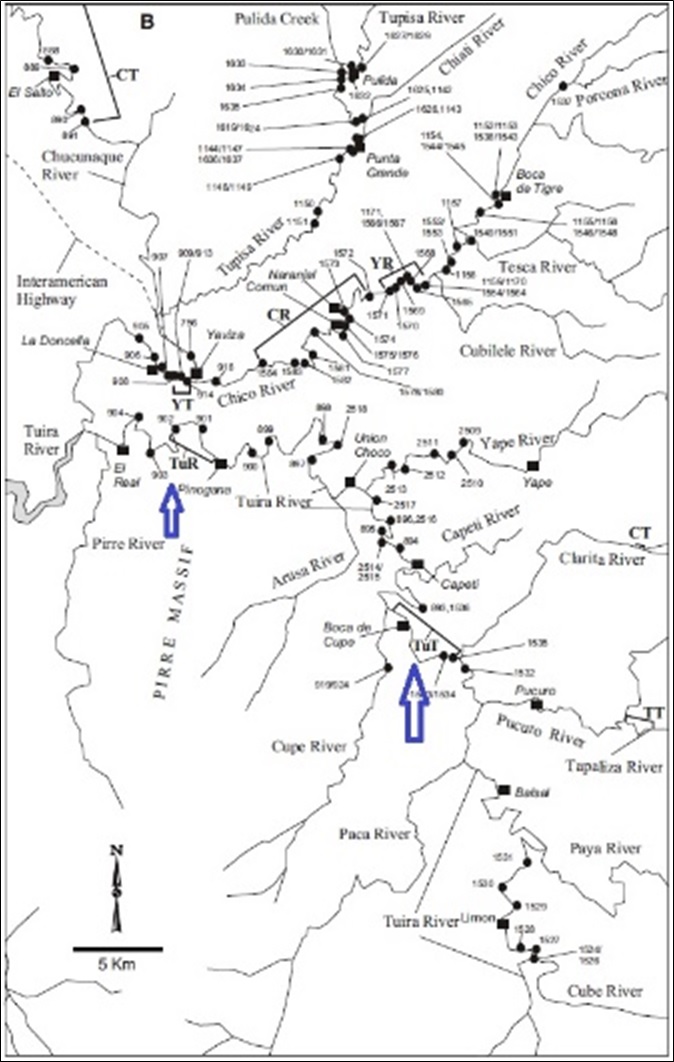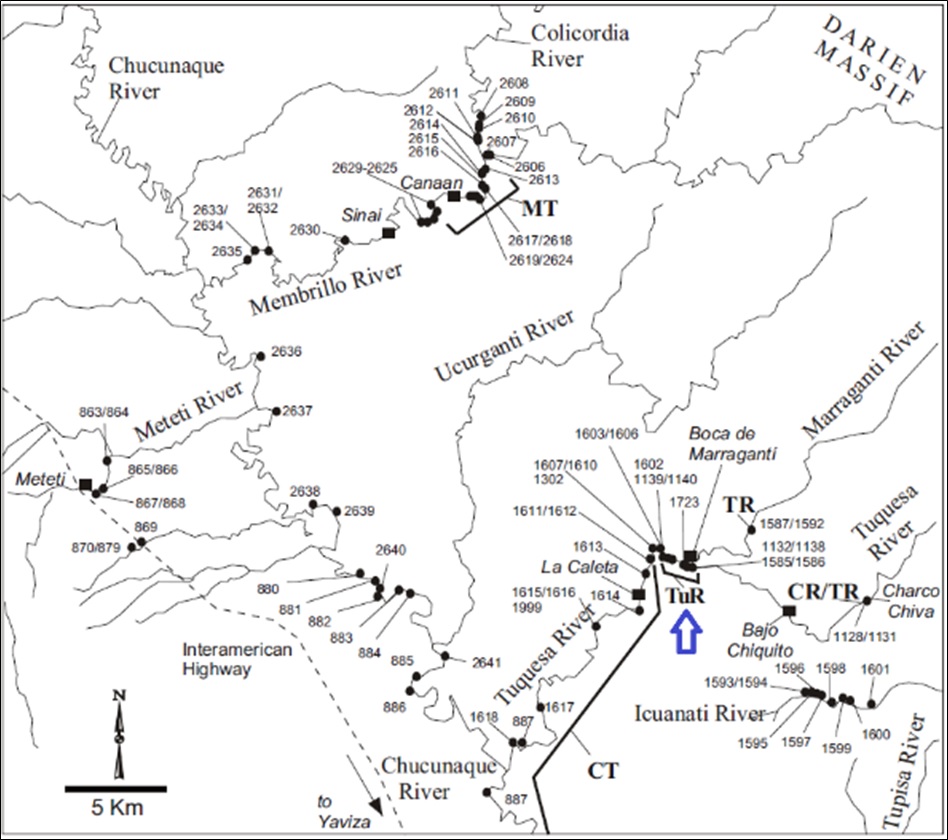Tuira Fm
Period:
Neogene
Age Interval:
Upper Miocene (Tortonian) - Coates et al. (2004)
Province:
Eastern Panama
Type Locality and Naming
- Sapper (1937). (correlation chart). Underlies Pucro sandstone Fm. Equivalent to the lower Gatún Fm of the Darien area. Middle Miocene.
- The Tuira Fm was named in the Esso Exploration and Production Inc., Annual Report, (1970) without reference to a type section.
- The stratotype (TuT) of the Tuira Fm, defined in Coates et al. (2004), lies along the Tuira River, from the Clarita River northwestward to its junction with the Cupe River (Figure 1). Reference sections (TuR) are located on the Tuquesa River (Figure 1), and on the Tuira River, 6 km east of El Real to Pinogana. (Figure 2). Darien area.
[Figure 1 (left): Stratotype (TuT) & the first Reference Section (TuR) of the Tuira Fm. Coates et al. (2004).]
[Figure 2 (right): Locality of the second Reference Section of the Tuira Fm Coates et al. (2004).]
Synonym:
Lithology and Thickness
The Tuira Fm (Figure 3) is largely marine, consisting of thin and regularly bedded alternations of blue gray graywacke and arkosic sandstone with dark green to black, silty claystone and siltstone. Gurocak-Orhun et al. (2017).
Thickness: The thickness of the Tuira Fm ranges from 500m in the northwest to about 1000m around Yaviza.
[Figure 3. Gray marls of Tortonian age from the Sambu Basin, Tuira Fm (8.04163°, −78.32661°, WGS84). Barat (2013) and Barat et al. (2014).]
Lithology Pattern:
Sandy limestone
Relationships and Distribution
Lower contact
The Tapaliza Fm across the Chucunaque-Tuira Basin. The lower contact is not exposed but is apparently conformable.
Upper contact
Regional extent
Eastern Panama
GeoJSON
{"type":"Feature","geometry":{"type":"MultiPolygon","coordinates":[[[[-79.61,9.61],[-79.48,9.64],[-79.23,9.6],[-78.99,9.56],[-78.49,9.45],[-78.08,9.29],[-77.84,9.09],[-77.4,8.7],[-77.35,8.59],[-77.3,8.42],[-77.18,8.02],[-77.26,7.82],[-77.39,7.66],[-77.56,7.46],[-77.73,7.31],[-77.83,7.24],[-77.89,7.24],[-78.01,7.33],[-78.25,7.61],[-78.38,7.9],[-78.43,8.14],[-78.4,8.31],[-78.51,8.49],[-78.64,8.67],[-78.88,8.86],[-79.18,8.99],[-79.35,9.03],[-79.37,9.04],[-79.42,9.09],[-79.52,9.13],[-79.52,9.17],[-79.54,9.21],[-79.54,9.3],[-79.54,9.35],[-79.62,9.34],[-79.7,9.33],[-79.8,9.41],[-79.75,9.49],[-79.61,9.61]]]]}}
Fossils
Crabs, abundant plant debris, scattered small mollusks, particularly pectinids, nuculanids, Notocorbula, sponges and abundant benthic foraminifera are typical. Many units have pervasive bioturbation or thalassinoid burrow systems. Occasional pebble breccia, shell beds, and stringers of rip-up clasts also occur. Locally, around the region of the Chico River, shelly volcanic sandstone and pebble conglomerate, and shell beds with large, thick-shelled mollusks, are more common.
Age
The Tuira Fm belongs to the lower part of the upper Miocene (11 to 9.5 Ma.) on the basis of its age-diagnostic calcareous nannofossils and planktic foraminifera.
Age Span:
Beginning stage:
Serravallian
Fraction up in beginning stage:
0.75
Beginning date (Ma):
12.17
Ending stage:
Tortonian
Fraction up in the ending stage:
0.5
Ending date (Ma):
9.44
Depositional setting
- Sediments were deposited at inner neritic (0–30 m) to middle bathyal (500–1500 m) depths.
- Paleoenvironments varied from middle to upper bathyal in the center of the Chucunaque-Tuira (C-T) Basin to shallower, neritic depths on its margins. The seaward Sambu Basin was as deep as the center of the C-T Basin. These paleoenvironments were mostly deep-water, low-oxygen facies, similar to those of the Eastern Pacific oxygen minimum zone and California borderland Basins.
- In the center of the C-T Basin and Sambu Basin, paleobathymetries of the Tuira Fm and its overlying and underlying formations show a progressive shallowing in the late Miocene from the middle bathyal, Tapaliza Fm and Membrillo Fm /Tuira Fm to the upper bathyal Chucunaque Fm, roughly 675 m, due to the uplift of the Isthmus of Panama.
Depositional pattern:
Additional Information
- Terry (1956, p.50). Though the name presumably was supplied by Terry, in his own publication he used the designation "lower Gatún".
- Wilson et al. (1957).
- Woodring (1960). Not properly defined. Miocene.
- Gertman (1969); Coates, Anthony G. et al. (2004); Todd & Collins (2005); Beu (2010); Landau et al. (2010); Barat et al. (2014); Gurocak-Orhun et al. (2017);
- Under https://www.mindat.org/paleo_strat.php?id=22296 the Tuira Fm is listed as belonging to the “Lara Gr”, however no information could be found about this group in the literature. Other formations included in this Group are unknown.
Compiler:
Jacques LeBlanc (2021), Stratigraphic Lexicon: The Onshore Cenozoic Sedimentary Formations of The Republic of Panama. Biosis: Biological Systems, 2(1), 173 pp. https://doi.org/10.37819/biosis.002.01.0095 (or via https://sites.google.com/site/leblancjacques)

